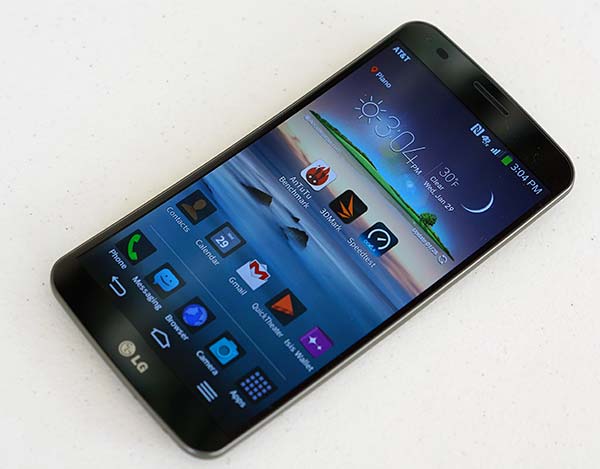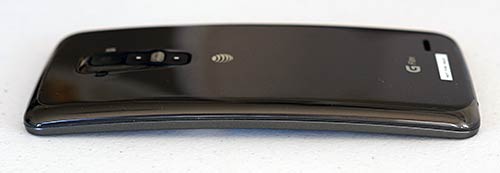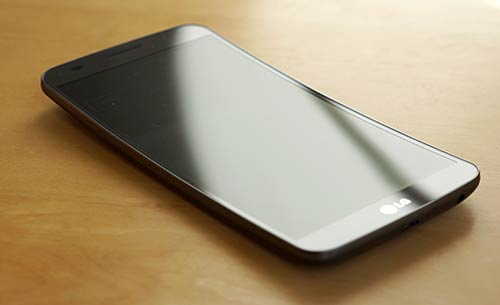LG G Flex Review
13:09
Smartphones are smartphones; generally they all look alike. So LG decided to throw us a curve ball with the LG G Flex. This is a curved and flexible phone, though the curve is gentle and there's little flex in this Flex. LG said they could've made it more bendable, but customers might equate a Gumby phone with cheapness. The G Flex is an Android 4.2.2 phablet with a 6" plastic AMOLED display. Don't worry; you wouldn't know it's not glass when looking at it, and plastic is what allows it to be flexible. Inside the G Flex is filled with flagship specs: a 2.2GHz Qualcomm Snapdragon 800 quad core CPU, 2 gigs of RAM, dual band WiFi 802.11ac, NFC and high megapixel cameras. The price, at least on AT&T and Sprint is higher than flagship: $299 with 2 year contract rather than the usual $199. That's a $100 curve. T-Mobile will also carry the LG, but they price things using monthly payments, which in the case of the G Flex will be 24 payments of $28 ($672 total).

The Curve
I had my doubts about curved phones, be it the LG G Flex or the Samsung Galaxy Round. But once I used the G Flex for a few hours, I found it more ergonomic and the screen produced fewer reflections than flat phones like the 6" Nokia Lumia 1520 and the 5.7"Samsung Galaxy Note 3. The 700mm radius curve isn't just there to fit the curve of your face; it also makes sense in the back pocket of your jeans (particularly if you have a 700mm curve to your bottom). I found videos more enjoyable on the curved display, even though there's no clear reason why this should be so: after all, it's not a 60" TV where a curve makes more sense to replicate big screen viewing at a movie theatre. Does the curve make this otherwise big phone feel easier to handle or more hand and face friendly? Yes, but this is still a very large phone.
It takes quite a bit of force to bend the phone, so it won't boing against your face or flap like a banana peel. The flexibility is there to make the phone more durable-- exerting force won't break it, it will simply flex a bit instead of cracking. Sure, if you try hard enough you could probably break it, but using bare hands that would be hard (I tried).

Design and Ergonomics
The smartphone has a bizarrely glossy gray striated back--does it look like metal? Nope. Does it look like classy plastic? Nope. It's a drab color and the high gloss attracts fingerprints and lint like iron shavings to a magnet. The saving grace is that the back isn't quite as slippery as you'd think and it's a self-healing polymer that can handle light scratches. Don't take your Xacto knife to it; we mean minor scratches from keys in your pocket or grit on the patio. It can take a few hours and some magic genie style rubbing to make scratches disappear: heat and friction are the key.
Like the LG G2, the volume and power buttons are on the back of the phone just below the camera lens. LG is sticking with this design element, and they feel it's ergonomic because your fingers will naturally fall on those buttons and it keeps the sides tidy. I'm not sure untidy smartphone sides bothered many of us, but the buttons do fall in approximately the right location for tactile use. I still find myself looking at the backside of the phone to make sure I don't accidentally hit the power button instead of volume when watching a video.
The phone has a micro USB port and 3.5mm headphone jack on the bottom, and the micro SIM card slot is on the left (you'll need a paperclip to eject the SIM tray). Overall it's a cleanly designed phone and the front face is dominated by the big display thanks to tiny side bezels. The G Flex uses on-screen Android buttons rather than hardware or capacitive buttons, so the phone's front is broken only by the earpiece and LG logo at the bottom.
The single rear-firing speaker is loud enough for personal playback in a quiet and it's not terribly shrill or harsh but it's not among the best in terms of volume or fullness. For visual notifications, the G Flex has front and rear notification LEDs and you can customize the LED colors.
Display
The one spec that isn't flagship? Display resolution. It's a 720p (1280 x 720) display rather than the usual full HD 1920 x 1080. The technology just isn't there yet to make a full HD flexible display. 720p isn't horrendous, but on a phone with a bigger than average 6 inch screen, we noticed text wasn't quite as sharp as we'd like. The 245 ppi display also has a minor blue color bias that's more pronounced at the top. Honestly, most folks will look at this and think it's a colorful display with wide viewing angles before they notice the lack of pin sharpness. Since it's AMOLED, colors are very saturated and blacks are rich, and it's bright enough to combat outdoor light. We did note some temporary image retention, where the ghost of the previously viewed web page showed very, very faintly. This is something we've seen on some laptop touch screens, but not on phones. It's temporary, so it's not worrisome unless you notice it and find it distracting.
|
Calling and Data
Before we get lost in the thrall of the first flexible, curvy phone and speak of megahertz and graphics chips, let's stop to consider the LG G Flex as a phone. It's available on several major carriers, and both signal strength and call quality will vary by carrier and their coverage strength in a given area. That said, we tested both the AT&T and Sprint models, and AT&T has very strong cover in our area (Dallas, TX), while Sprint's isn't as strong. In both cases, calls were clear with average volume, but not as clear as the LG G2, Samsung Galaxy Note 3 and iPhone 5s. Data speeds on AT&T and Sprint's network were typical and in line with other phones from those carriers: the AT&T model's LTE connection delivered very quick download speeds averaging 24Mbps according to the speedtest.net app, while Sprint averaged 7.6 Mbps. In as much as we can separate a phone from its network's strengths and weaknesses, the LG G Flex has average call quality and LTE 4G data speeds are as good as they get with current high end 4G phones.
Horsepower and Software
Nothing has changed here from the LG G2 and other Android phones running on the same 2.2GHz quad core Qualcomm Snapdragon 800 quad core CPU with 2 gigs of RAM. It's a fast phone and that's the fastest CPU you can get in an Android device. LG's UI, though not light, doesn't bog down the device and it feels responsive at all times. Thanks to the fast CPU and Adreno 330 graphics, combined with the relatively low pixel count, 3D games fly.
The LG G Flex has 32 gigs of storage with approximately 24.5 gigs available for your use. It does not have a microSD card slot, so you're limited to internal storage and the cloud or a USB flash drive if you buy a USB OTG adapter.
Sorry, no Android 4.4 KitKat here, at least not until LG issues a software update. The phone ships with Android 4.2.2 Jelly Bean and LG's custom UI, which bears similarity to Samsung's TouchWiz, right down to the 4-tabbed settings interface and split-window multitasking. Not that we mind the multi-tasking, which LG handles nicely, though the list of supported apps is shorter than Samsung's.
Cameras
This is the same camera used in the LG G2, and we found a lot to like then and now. It's a 13 megapixel camera with LED flash, HDR and a variety of shooting modes like VR panorama, beauty shot, Intelligent Auto (a feature found on Sony cameras since this is a Sony module), burst shot and time catch (several frames captured over time to show a figure or object as it moves across the screen). Some have complained about the G Flex camera, but I found that like the G2, it captures sharp photos with plenty of detail. Colors are lifelike and natural and exposure is pretty good. The camera can shoot 1080p, 30 fps and 60 fps video, and it can shoot 4K UHD 3840 x 2160 video. It's a bit ahead of its time since few folks have 4K displays, but it's a great marketing point even if the video isn't mind-bogglingly pin sharp (hey, it's a camera phone).
A front 2.1MP camera handles video chat on Skype and other services nicely. Given the fairly high resolution, video isn't as blocky or noisy as on competing phones with lower megapixel ratings.
AV Remote
What's an Android phone without an IR blaster and AV remote app? The LG has QuickRemote, and it can control your TV, cable box, AV receiver, DVD player, Blu-ray player, projector and air conditioner. This is a pure remote control minus the TV grid found on the HTC One and various Samsung Galaxy phones and tablets. Unlike the LG G Pad 8.3 tablet that has a very pared down remote, this one controls all kinds of gear and many, many brands and models are supported.
Battery Life
Big phones need big batteries, and the LG G Flex has an ample 3500 mAh Lithium Ion polymer battery that's sealed inside (yes, it's curved too). Given the power efficiency of the Snapdragon 800 and the relatively low resolution display, battery life on the G Flex is very good. With moderate use, we managed two days on a charge with brightness set to 50% and LTE turned on (we tested both AT&T and Sprint models).
|



0 comments